Photo courtesy of Long Beach Opera
The greeting on Long Beach Opera’s website is a bold pronouncement: Opera Like You’ve Never Seen It.
Some longtime subscribers may not appreciate the irony that opera (as in costumes, arias, a plot and an orchestral score…) is something they’re not seeing much of these days. To be sure, there have been a few since James Darrah took the reins just in time to steer the company through the COVID era — including a couple of greats — but the overall trend has been to narrow the scope of what Southern California’s oldest opera company is offering.
That trend will hold for the 2024-25 season, as Long Beach Opera is producing only three staged events, comprising a total of five performances, plus a two-day film festival — all showcasing the compositions of Pauline Oliveros.
The season opener, Earth Ears: A Sonic Ritual (at San Pedro’s Angels Gate Cultural Center — as fine a site for such an event as you could want), was about as narrow — and non-operatic — as it gets. Earth Ears has no score at all, only a series of guideposts for what indeterminate musicians (“Any instrument or voice capable of […] following the given instructions may be used”) should do. “First Cycle: Use only one tone, chord or sound in the pattern. (The pattern may be more or less complicated rhythmically.) Use only one option during the transition. Use only one sound/silence during the change.” Etc.
Under Darrah and Christopher Roundtree’s direction, this meant violin, harp, a few horns, and a couple of vocalists taking us through 70 minutes of minimalist improv as we sat in a room full of shredded newspaper (much more thoughtful and aesthetically pleasing than it sounds), which whispered with every move we made as an intentional and interactional part of the overall experience. “Deep Listening,” they call it, attending to every contribution to the auditory moment, whether a patron’s fiddling with her handbag or the cawing of seagulls on the wing.
If we think of music as a specialized subgenre of sound art with a particular emphasis on melody, harmony, rhythm, and structure, Earth Ears is less music than a type of aleatory exercise that is a sound-art commonplace. A special pitfall of such exercises is knowing when to say when. Something that at 15 minutes may be diverting and meditative may be tedious at a half-hour. After the performance I spoke with an attendee who had never experienced anything like this and so was turned on by the novelty — yet even she felt that Earth Ears dragged on too long. Another felt the same but was willing to forgive the self-indulgence in the hopes that the works to come this season may somehow redeem it.
Under Darrah’s leadership, Long Beach Opera doesn’t seem concerned about expectations that may come with having “opera” in your name and a history of delivering full-blown spectacles year in and year out. But that’s not necessarily a bad thing. It comes down to what you’re doing in place of living up to those expectations.
But another irony of today’s expectation-breaking Long Beach Opera is that their best work over the last five years has been actual operas, not the alternate programming they’ve offered. Hopefully February’s El relicario de los animales (which isn’t billed as an opera per se) and April’s The Library of Maps (which is) will add to that list.



